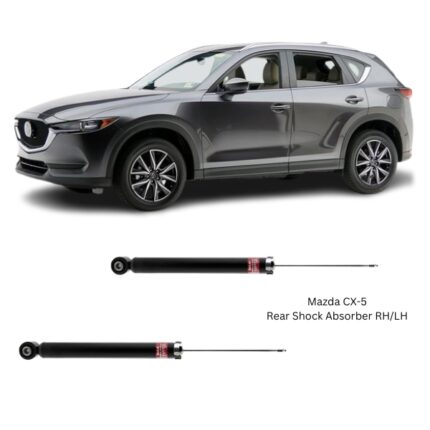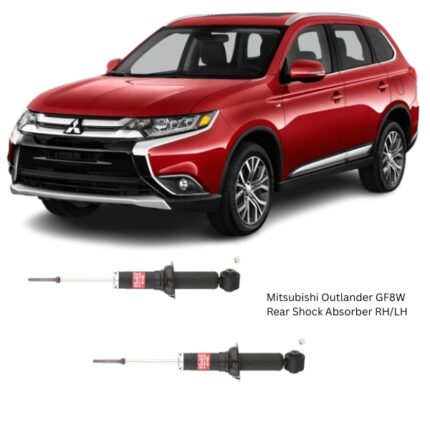Get Mitsubishi Outlander GF8W Rear Shock Absorber RH/LH 3410059 in Kenya
The rear shock absorber, fitted on the right-hand (RH) and left-hand (LH) sides of a vehicle, is one of the most essential parts of the suspension system. Although it may appear to be a simple tube-shaped component, its role in maintaining safety, stability, and comfort while driving is enormous. Without properly working shock absorbers, a vehicle quickly becomes unstable, difficult to control, and uncomfortable for passengers. This description explains everything important you need to know about rear shock absorbers: their purpose, how they are built, the different types available, the signs of wear, and why timely replacement is critical.
1. Purpose and Function
At the core, the rear shock absorber is designed to control suspension movement. When a car drives over a bump, dip, or rough road, the suspension springs compress and expand to absorb the impact. If left uncontrolled, those springs would continue bouncing repeatedly, making the car unstable. The shock absorber prevents this uncontrolled bouncing by dampening the energy from the springs and turning it into heat, which is safely dissipated.
The main functions of the rear shock absorber are:
-
Stability: Keeps the rear end of the vehicle steady, especially during turns and lane changes.
-
Comfort: Absorbs shocks and vibrations so passengers experience a smoother ride.
-
Traction: Ensures the rear tires maintain contact with the road, which is vital for grip.
-
Braking Support: Reduces rear lift when braking, which improves stopping performance.
-
Load Management: Balances and stabilizes the car when carrying heavy loads or passengers at the back.
Without effective shock absorbers, a vehicle becomes unsafe to drive, no matter how good the tires or brakes are.
2. Construction and Design
A rear shock absorber may look simple, but it is carefully engineered for durability and precision. Its basic construction includes:
-
Outer Tube (Cylinder): The main body that contains hydraulic fluid.
-
Piston and Rod: The piston moves inside the cylinder, attached to a polished rod that slides smoothly.
-
Valves: Small calibrated passages that control the flow of hydraulic fluid, providing the actual “damping effect.”
-
Seals: Keep the fluid inside and dirt outside.
-
Bushings and Mounts: Rubber or polyurethane parts that connect the shock absorber to the chassis and suspension arm, while reducing vibrations and noise.
Most rear shock absorbers are either twin-tube (a working cylinder with an outer reservoir) or mono-tube (a single larger cylinder, often gas-pressurized). Both designs have their advantages depending on the vehicle’s purpose.
3. Types of Rear Shock Absorbers
Not all rear shock absorbers are the same. The main types include:
-
Hydraulic (Oil-Filled): The traditional design, reliable for standard driving conditions.
-
Gas-Charged: Uses pressurized nitrogen gas in addition to hydraulic oil, preventing foaming and ensuring consistent performance.
-
Heavy-Duty: Built stronger for vehicles that carry loads or drive in rough conditions.
-
Adjustable: Allow tuning of stiffness, useful for performance-oriented drivers.
-
Air Shocks: Provide height adjustment and load leveling, common in SUVs and larger vehicles.
The choice depends on how the vehicle is used—whether for city driving, long-distance travel, or heavy-duty work.
4. RH and LH Specific Fitment
The designation RH (Right-Hand) and LH (Left-Hand) is important because some rear shock absorbers are not interchangeable. They are designed to fit precisely on one side of the vehicle to match suspension geometry and mounting brackets. Installing the wrong side can cause poor alignment, uneven wear, or even unsafe handling. For best performance, always install the correct RH and LH shocks as specified.
5. Signs of Worn Rear Shock Absorbers
Shock absorbers wear out gradually, so drivers may not notice right away. However, ignoring the signs can put safety at risk. Common symptoms of worn rear shocks include:
-
Excessive Bouncing: After hitting a bump, the vehicle continues to bounce instead of settling quickly.
-
Poor Handling: The car feels unstable or drifts while cornering.
-
Braking Issues: Rear end lifts during hard braking, increasing stopping distance.
-
Uneven Tire Wear: Tires show cupping or patchy tread wear from poor road contact.
-
Leaking Fluid: Oil seeping from the shock body indicates failure.
-
Unusual Noises: Clunking, rattling, or knocking sounds from the suspension.
When these signs appear, replacement is necessary. Driving with worn shocks reduces safety and damages other suspension parts.
6. Replacement and Maintenance
To maintain balance and safety, rear shocks should always be replaced in pairs—both RH and LH at the same time. Replacing only one side creates uneven damping and handling problems.
Important guidelines for replacement:
-
Inspect mounting hardware and bushings and replace if worn.
-
Tighten bolts to correct torque specifications.
-
Check suspension springs, as weak springs reduce the effectiveness of new shocks.
-
Consider a wheel alignment after installation to maintain stability.
-
Inspect shocks regularly, ideally every 20,000–30,000 kilometers, depending on road conditions.
With proper maintenance, quality shock absorbers can last tens of thousands of kilometers.
7. Benefits of Properly Functioning Rear Shock Absorbers
When rear shocks are in good condition, they bring significant benefits:
-
Improved Safety: Stable handling in all conditions.
-
Comfortable Ride: Less vibration and smoother travel for passengers.
-
Better Tire Life: Even wear from consistent road contact.
-
Shorter Braking Distances: Less rear-end lift when braking.
-
Less Strain on Suspension: Protects springs, bushings, and chassis from premature wear.
-
Confidence for the Driver: Vehicle feels predictable and easy to control.
These benefits highlight why shock absorbers are not just about comfort—they are directly linked to safety.
8. Durability and Materials
Modern rear shock absorbers are built to last. They are made from high-strength steel with anti-corrosion coatings to resist rust and damage. Piston rods are often chrome-plated for smooth operation. Gas-charged designs perform better under tough conditions by resisting overheating.
Follow us on Facebook for more parts.





Reviews
Clear filtersThere are no reviews yet.